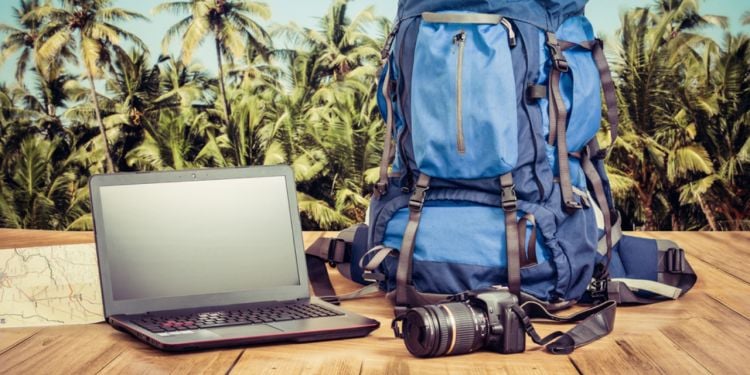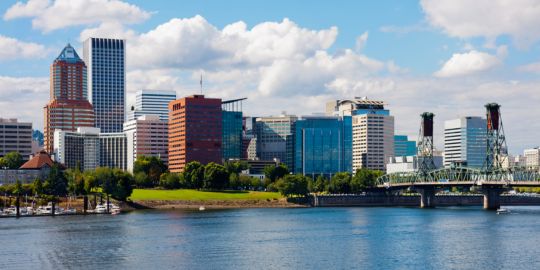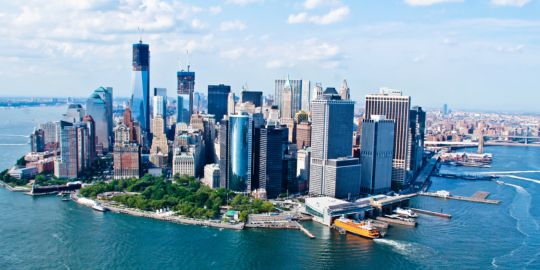How to become a digital nomad in the United States

It's hard to find a digital nomad out there who doesn't have a road trip through the US on their bucket list. The third-largest country in the world has a lot to offer its visitors — from the thriving innovation-driven environment to the incredible coastline and world-famous sightseeing. Before you hop on the plane, there are a few pesky details to take care of, like sorting out visas and taxes and making sure you've got a good internet connection.
Why is the United States a good nomad destination?
Most digital nomads have considered traveling to the US at least once, and many have the country on their list of must-visit destinations. Home to Silicon Valley, the world's number one tech, innovation, and startup hub, the globe's third-largest country is one of the best places for networking, coworking, bringing your projects to life, and getting ideas and inspiration. The thriving entrepreneurial scene is the main factor in making the US a popular digital nomad destination and the country's many natural, historical, and cultural attractions. Bear in mind that the US is not a low-cost destination, and staying here for the long term will be so much more expensive than Thailand or Indonesia, for example. However, if you're careful with your budget and prepared to make some compromises, being a digital nomad in the USA is definitely doable.
Visa requirements for digital nomads in the USA
Before you can begin your free-wheeling digital nomad life in the USA, you have to have an appropriate visa that allows you to work remotely in the United States legally. Depending on your nationality and circumstances, options may include a business visa (such as B-1), an employment-based visa, or potentially exploring other visa categories suitable for remote work.
Unlike some countries, the United States has no specific visa category designated as a "digital nomad visa". The existing visa categories in the United States are primarily designed for specific purposes such as employment, business, study, or family-based immigration. However, the B-1 business visa or the J-1 exchange visitor visa may be used by those engaging in remote work or trying their hand at entrepreneurial ventures while in the United States. These visas typically require you to stick to specific criteria and limitations, and they may not provide a long-term solution for digital nomads who intend to stay in the country for an extended period.
If you are being paid by your employer or clients in your home country while you are traveling in the US, it generally falls under the category of remote work or providing services to clients outside of the United States. In this case, as long as the work is conducted for entities or individuals outside of the United States and you are not performing work for or receiving payment from US-based companies' clients, it is generally considered acceptable – so long as you are just in the USA temporarily, on a visitor or tourist visa.
It's important to note that even though you may be working remotely for your home country, you are still subject to the immigration rules and regulations of the country you are physically present. Therefore, it's crucial to ensure that you comply with the terms of your visa and are not engaging in any activities that would be considered unauthorized employment in the United States.
As always, it is recommended to consult with an immigration attorney or seek guidance from the US embassy or consulate in your home country for specific advice and to ensure compliance with immigration regulations regarding earning income from your home country while traveling in the USA.
Tax obligations for digital nomads in the USA
Taxes can be complex for digital nomads, as you may be planning to provide services to clients from multiple international locations, as well as the USA. It's essential to understand your tax obligations as a digital nomad working in the United States, which means that before you can start daydreaming about your new lifestyle, you have to do the leg work of researching tax laws, potential tax liabilities, and reporting requirements.
Health and travel insurance in the USA
Though you are going to be living a somewhat rootless life, it's really important to make sure the basics are taken care of. If you don't have a regular 9 to 5, you potentially are also not getting health insurance provided by your employer, and without family support or a regular home base, your life might lack some basic stability. One way to put your mind at rest when embarking on an adventure like this is getting good health and travel insurance coverage while in the United States. There are lots of international health insurance options that provide comprehensive coverage for medical expenses and emergency situations – and some are geared towards digital nomads. Providers like Genki and SafeyWing offer products that take into account all of the aspects of the digital nomad lifestyle.
Cost of living in the USA
There are lots of different ways to be a digital nomad. Do you plan to live in several places in short-term rentals or Airbnb, or are you planning on being a nomad further and trying out living in a camper or renovating a van? Maybe you're planning to stay with friends part of the time and couch-surf your way across the country. Whichever it is, we highly recommend that you research and plan for the cost of living in the areas you intend to stay and factor in other things like vehicle costs, gas, and campsite costs if you're sleeping in a camper. Remember that living expenses can vary significantly depending on the region and city. There are plenty of online guides and YouTube videos that break down the reality of living as a digital nomad, but it's really important you have a realistic expectation of costs. Bear in mind also that things can change quickly – it's really important to have an emergency fund so that you can get home quickly if you need to. The COVID-19 epidemic was not anticipated, but there are global events that can definitely put a spanner in the works, and it's best to be prepared for worst-case scenarios.
Time zones in the USA
Consider the time zone differences between your home country and the United States. Consider how it may impact your work schedule, communication with clients or colleagues, and maintaining a work-life balance. Not all jobs center on meeting at specific times or being available to clients at certain hours, but the reality is that many do – be realistic about whether your work will suffer if it's the middle of the night where you are when the rest of your team is doing the daily meeting. Remember, the US contains multiple time zones, so you may hang around the East Coast or the West Coast more, depending on where most of your clients are based.
Be realistic…
Although being a digital nomad might sound dreamy, some downsides can come with the itinerant lifestyle. Make sure to take your rose-tinted spectacles off and look at the other side of the story, too. Reported negatives associated with being a digital nomad include:
- isolation and loneliness;
- work-life balance challenges;
- lack of routine;
- limited access to healthcare;
- legal and administrative complexities;
- uncertain income and financial stability;
- travel fatigue.
Aspiring digital nomads should be aware of these potential challenges and consider strategies to address them. There are plenty of online communities for digital nomads where you can ask questions and gain support; we recommend the digital nomad subreddit to get started.
Best cities in the USA to work from
If it's inspiration you are looking for, there is no skipping New York on your trip. Praised by Frank Sinatra as the place for the ultimate skill test ('If I can make it here, I can make it anywhere'), New York is a place of motivation, exchange, and achievement.
If what you are looking for is combining your work hours with some relaxing beach time and the chance of running into celebrities on the street, Los Angeles is the perfect spot to explore. Known for its stunning coastline, young and hip work culture, vibrant boutique coffee scene, and one-of-a-kind nightlife, LA is one of the world's most popular travel destinations and home to a growing freelance and digital nomad community.
San Francisco is the Bay Area's centerpiece and one of the most visited cities in the United States and the world. With its hilly terrain, signature summer fog, and all things high-tech, it's a city where the hippie and yuppie cultures live alongside the backdrop of mushrooming young startups. Here, you will not only find a myriad of coffee shops catering to the freelancer but also one of the best possible selections of coworking spaces and world-class networking.
Dallas may not be the first city that comes to mind when you think of a digital nomad lifestyle, yet it ranks among the top nomad-friendly cities in the US. The city is rated highly for safety and, what's of note, walkability. Dallas also has more restaurants per capita than New York City, offering a friendly setting for nomads and foodies alike.
The Internet and coworking spaces in the USA
If possible, try and figure out in advance if reliable and high-speed internet connectivity is available in the locations you plan to work from. Research co-working spaces, libraries, cafes, or accommodations with reliable internet access to support your remote work requirements. Some work is much more suited to the digital nomad lifestyle than others, so be realistic about what kind of space you need to work in and how much stability you require. If you need dead silence and your screen and desk positioned in very specific ways, being a digital nomad might not be your jam.
The average internet speed in the US is 99.3 Mbps — but the actual speeds vary from state to state.
The East Coast boasts the highest internet speeds in the US — they are often more than double the speeds in some rural areas in the country. As of 2023, the top ten states for fast internet are:
- District of Columbia – 473.8 Mbps;
- Delaware – 469.7 Mbps;
- Washington – 451 Mbps;
- Rhode Island – 433.3 Mbps;
- Pennsylvania – 430.8 Mbps;
- New Jersey – 427.8 Mbps;
- Texas – 425.9 Mbps;
- Georgia – 414.9 Mbps.
The states with the slowest internet speeds are Arkansas, Oklahoma, Mississippi, Montana, and Wyoming. Big cities such as New York and Los Angeles offer no shortage of coworking facilities, cafés, and eateries to work from and mingle. If you choose to settle in the suburbs, however, you may need to go for a drive to the nearest coffee shop or choose to work from home.
Coworking spaces in New York
The Farm SoHo, 447, Broadway, 2nd Floor
The Commons 157, East 86th Street, 4th Floor
Primary, 26, Broadway
Coworking spaces in Los Angeles
Cross Campus, 800, Wilshire Blvd
Village Workspaces, 11845 W, Olympic Blvd #1100
LAX Coworking, Ste., 9100 S, Sepulveda Blvd
Coworking spaces in San Francisco
Bespoke Coworking, Level 4, #450A, 845 Market St.
rel="nofollow"DropDesk, 1186, Valencia St
Canopy, 2193, Fillmore St.
Coworking spaces in Dallas
NÅD Coworking, 17290, Preston Rd.
Common Desk, Deep Ellum, 2919, Commerce St.
SPACES, 1919, McKinney Ave.
Useful links:









